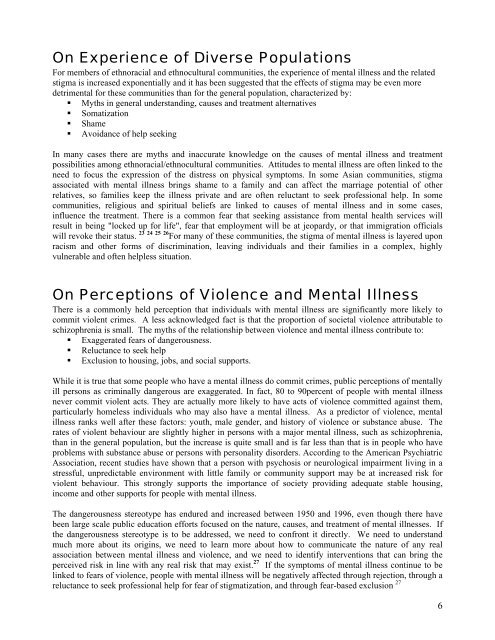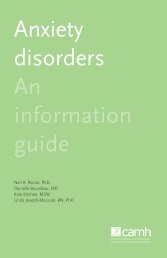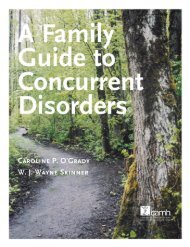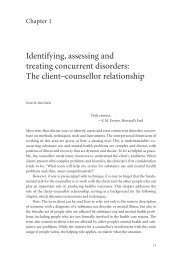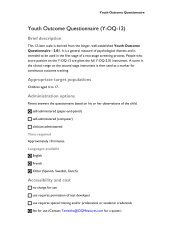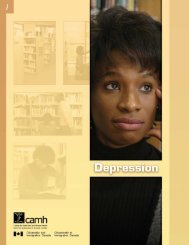Addressing Stigma: Increasing Public Understanding of Mental Illness
Addressing Stigma: Increasing Public Understanding of Mental Illness
Addressing Stigma: Increasing Public Understanding of Mental Illness
You also want an ePaper? Increase the reach of your titles
YUMPU automatically turns print PDFs into web optimized ePapers that Google loves.
On Experience <strong>of</strong> Diverse Populations<br />
For members <strong>of</strong> ethnoracial and ethnocultural communities, the experience <strong>of</strong> mental illness and the related<br />
stigma is increased exponentially and it has been suggested that the effects <strong>of</strong> stigma may be even more<br />
detrimental for these communities than for the general population, characterized by:<br />
• Myths in general understanding, causes and treatment alternatives<br />
• Somatization<br />
• Shame<br />
• Avoidance <strong>of</strong> help seeking<br />
In many cases there are myths and inaccurate knowledge on the causes <strong>of</strong> mental illness and treatment<br />
possibilities among ethnoracial/ethnocultural communities. Attitudes to mental illness are <strong>of</strong>ten linked to the<br />
need to focus the expression <strong>of</strong> the distress on physical symptoms. In some Asian communities, stigma<br />
associated with mental illness brings shame to a family and can affect the marriage potential <strong>of</strong> other<br />
relatives, so families keep the illness private and are <strong>of</strong>ten reluctant to seek pr<strong>of</strong>essional help. In some<br />
communities, religious and spiritual beliefs are linked to causes <strong>of</strong> mental illness and in some cases,<br />
influence the treatment. There is a common fear that seeking assistance from mental health services will<br />
result in being "locked up for life", fear that employment will be at jeopardy, or that immigration <strong>of</strong>ficials<br />
will revoke their status. 23 24 25 26 For many <strong>of</strong> these communities, the stigma <strong>of</strong> mental illness is layered upon<br />
racism and other forms <strong>of</strong> discrimination, leaving individuals and their families in a complex, highly<br />
vulnerable and <strong>of</strong>ten helpless situation.<br />
On Perceptions <strong>of</strong> Violence and <strong>Mental</strong> <strong>Illness</strong><br />
There is a commonly held perception that individuals with mental illness are significantly more likely to<br />
commit violent crimes. A less acknowledged fact is that the proportion <strong>of</strong> societal violence attributable to<br />
schizophrenia is small. The myths <strong>of</strong> the relationship between violence and mental illness contribute to:<br />
• Exaggerated fears <strong>of</strong> dangerousness.<br />
• Reluctance to seek help<br />
• Exclusion to housing, jobs, and social supports.<br />
While it is true that some people who have a mental illness do commit crimes, public perceptions <strong>of</strong> mentally<br />
ill persons as criminally dangerous are exaggerated. In fact, 80 to 90percent <strong>of</strong> people with mental illness<br />
never commit violent acts. They are actually more likely to have acts <strong>of</strong> violence committed against them,<br />
particularly homeless individuals who may also have a mental illness. As a predictor <strong>of</strong> violence, mental<br />
illness ranks well after these factors: youth, male gender, and history <strong>of</strong> violence or substance abuse. The<br />
rates <strong>of</strong> violent behaviour are slightly higher in persons with a major mental illness, such as schizophrenia,<br />
than in the general population, but the increase is quite small and is far less than that is in people who have<br />
problems with substance abuse or persons with personality disorders. According to the American Psychiatric<br />
Association, recent studies have shown that a person with psychosis or neurological impairment living in a<br />
stressful, unpredictable environment with little family or community support may be at increased risk for<br />
violent behaviour. This strongly supports the importance <strong>of</strong> society providing adequate stable housing,<br />
income and other supports for people with mental illness.<br />
The dangerousness stereotype has endured and increased between 1950 and 1996, even though there have<br />
been large scale public education efforts focused on the nature, causes, and treatment <strong>of</strong> mental illnesses. If<br />
the dangerousness stereotype is to be addressed, we need to confront it directly. We need to understand<br />
much more about its origins, we need to learn more about how to communicate the nature <strong>of</strong> any real<br />
association between mental illness and violence, and we need to identify interventions that can bring the<br />
perceived risk in line with any real risk that may exist. 27 If the symptoms <strong>of</strong> mental illness continue to be<br />
linked to fears <strong>of</strong> violence, people with mental illness will be negatively affected through rejection, through a<br />
reluctance to seek pr<strong>of</strong>essional help for fear <strong>of</strong> stigmatization, and through fear-based exclusion 27 6


